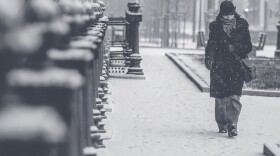Another year, another frigid January in Michigan. Scientists predict this extreme winter weather could be the new normal for the Midwest, thanks to climate change.
Some of us still need some clarification on how climate change is making winter worse, so we're republishing this story from the last time it reached these low temperatures in January 2018.
In case you hadn't noticed, it is very, very cold outside. In fact, the past two weeks in Michigan have seen temperatures lower than in Iceland, most of Alaska, and even some parts of Antarctica.
Cold weather isn’t exactly unusual in Michigan, but with low temperatures once again hitting the single (and negative) digits, I wanted to know: are these frigid winters the new normal?
To get to the bottom of this, I emailed Dr. Jeff Masters, the co-founder of Weather Underground.
He says that although he’s seen some rough winters in the 50 years he’s lived in Michigan, this year is shaping up to be one of the worst.
“The relentless, intense cold that has gripped the Great Lakes State since Christmas has been remarkable, and will enter epic territory late this week,” Masters said.
That’s because both Flint and Detroit are looking at a streak of 12 consecutive days with a high below 20°F by Saturday.
“The record-longest streak with highs below 20°F is 11 days in Detroit and 12 days in Flint,” explains Masters.
“Both streaks occurred during the infamous winter of 1978-79, when I was a freshman at the University of Michigan. I can remember trekking with a frozen face across the frozen tundra of the Michigan ‘Diag’ on my way to classes that winter, wondering when I might see a winter of this epic intensity again.”
(Masters experienced one of the only snow days in U of M history that winter. There wasn’t another snow day until 2014, by which time I was a student.)
So what is the cause of this almost-record-setting cold snap? Masters highlighted five key points:
Blame the polar vortex.
Remember way back in January 2014, when everyone was freaking out about the polar vortex? Well, Masters says the vortex is once again the source of our frozen noses and lakes.

He explains, “The polar vortex is a permanent feature of the Arctic atmosphere in winter, and consists of a counter-clockwise rotating area of low pressure centered over the North Pole. Inside of the vortex is a region of intensely cold Arctic air, which usually stays bottled up to our north.”
A strong polar vortex traps the coldest air around the polar region, insulating it from escaping to Europe and North America.
But the polar vortex is weakening, allowing cold air to escape beyond the polar region.
This could be because the Arctic is warming. New research suggests that as the Arctic sea ice melts, warmth escapes to the oceans, releasing energy that weakens the polar vortex winds."
Masters says, "Several groups of scientists have found that warming in the Arctic and the resulting loss of sea ice are making it more likely that the jet stream will take dramatic wintertime dips and push intense cold outbreaks into mid-latitude areas, such as the eastern U.S."
Global warming doesn’t get rid of weather.
Despite what some people say...
In the East, it could be the COLDEST New Year’s Eve on record. Perhaps we could use a little bit of that good old Global Warming that our Country, but not other countries, was going to pay TRILLIONS OF DOLLARS to protect against. Bundle up!
— Donald J. Trump (@realDonaldTrump) December 29, 2017
...global warming doesn’t stop winter from happening.
“We can still expect cold waves and heat waves, even as greenhouse gases make our overall climate warmer over time. And since global warming doesn’t change the fact that Earth is tilted on its axis, winter still happens,” says Masters.
Average annual temperatures are still on the rise, despite the occasional cold snap. Masters points out that 2017 was actually the third warmest year on record.
“The only warmer years (for January– November) were 2012 and 2016, according to NOAA. For 2017, NOAA reported more than 33,000 daily record highs, but only about 9000 daily record lows.”
Climate change may be raising the odds of winter cold waves in the eastern U.S.
Although climate change can't stop the general ebb and flow of the seasons, it does lead to more extreme weather, higher highs, and lower lows.
"Since these cold waves are occurring in a warmer climate, all-time cold temperature records for a particular date and location are getting harder to break," says Masters. "However, these cold waves are staying put longer, enabling us to break all-time duration records for intense cold."
Two weeks do not a winter make.
Sure, it might be horrifically cold right now, but there’s still a lot of winter left.
“Looking ahead,” explains Masters, “NOAA’s 3- to 4-week temperature outlook calls for above-average temperatures to prevail across much of the nation in mid- to late January.”
Plus, it should be noted that this year likely won’t break the top five coldest winters in Michigan history. According to NOAA, the coldest 3-month winter periods (Dec – Feb) in Michigan history were 1903/04, 1917/18, 1919/20. 1962/63, and 1916/17.
The Great Lakes are freezing rapidly.

“The intense cold of recent days has accelerated ice formation on the Great Lakes, which were all experiencing above-average levels of ice cover as of January 3.”
And therefore the lake-effect snow, which occurs when cold air travels over warm water, will soon subside.
Masters says not to expect any more monster storms like the record-smashing 64 inches of snow that fell in 60 hours in Erie, Pennsylvania, during Christmas week.
In other words, this extreme cold snap will end soon. But in the meantime, stay safe and dream of warm Michigan summers...

This story was originally published Wednesday, January 3, 2018.






